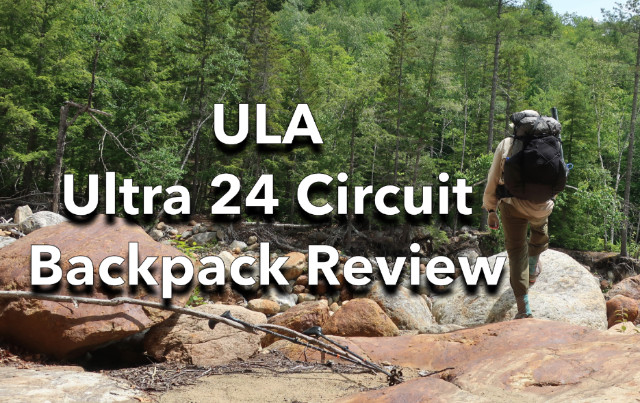The ULA Ultra 24 Circuit (68L) is an ultralight-style roll-top backpack made using a new ultralight waterproof fabric called Ultra that’s significantly more abrasion resistant than Dyneema DCF or the Robic Nylon used in other lightweight backpacks. If you’ve already been evaluating a ULA Circuit backpack for purchase, the only significant difference between the Ultra 24 Circuit and the baseline ULA Circuit made with 400 denier Robic Nylon is this new fabric, which is more expensive and is only available in black and grey.
Specs at a Glance
- Weight: 34.7 oz (size medium)
- Volume: 68 Liters incl. extension collar and external pockets
- Main pack bag volume: 47.5 Liters incl. extension collar
- Fabric: Ultra 200 and Ultra 400 in high wear areas
- Mfg. Rec’d Max Load: 30 lbs
- Mfg. Rec’s Base Weight: 15 lbs
- Torso Lengths: 15-18″, 18-21″, 21-24″, 24″+
- Hip Belt Sizing: 26-30″, 30-34″, 34-38″, 38-40″, 42-47″, 47″+
- Seam-taped: No
- Hydration system compatibility: No
- Load lifters: No
- Bear canister compatibility: BV500 and Garcia fit vertically, all other Bear Vault sizes including the BV475, fit horizontally.
- Made in the USA
- For complete specs, visit ULA’s Ultra 24 Circuit Product Page
About Ultra
If all this talk of new ultralight fabrics and their technical merits makes your head spin, you’re not alone, so I’ll boil it down. This new Ultra material is considered an order of magnitude more abrasion resistant than Dyneema Composite Fabrics and its hybrids as well as Robic Nylon or the High Tenacity Nylon, which is now used in packs made by Osprey, Gregory, Granite Gear, and others.
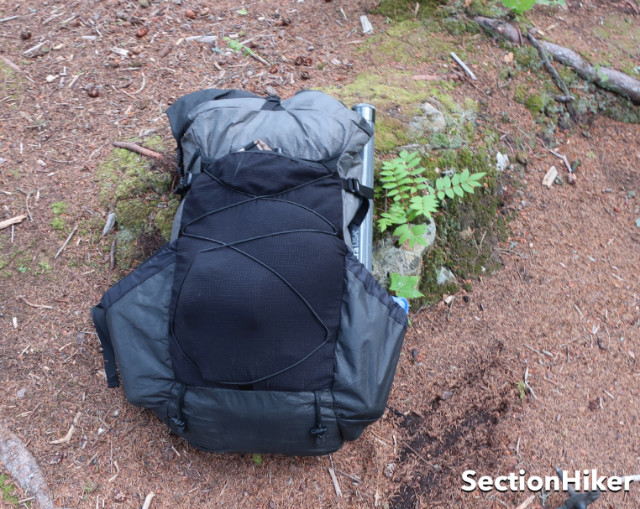
Backpack fabric experiences abrasion when you put your pack down on sand, gravel, scrape against rock walls, or bushwhack through dense foliage. Over time this can thin or hole the fabric so it leaks moisture, holes, or tears. The thinner the fabric (usually measured in denier, abbreviated D, as in 400D), the faster it will abrade. Ultra is also more environmentally friendly to manufacture and recycle than DCF or traditional nylons including Robic, although it’s still susceptible to UV damage from sunlight like Dyneema Composite Fabrics.
This increased abrasion resistance is useful for people who backpack frequently in mountains, deserts, or canyon country, but is less important for more casual backpackers where the use of Dyneema Composite Fabrics or the high Denier 400D Robic Nylon found in ULAs other backpacks provides more than adequate durability.
Backpack Storage and Organization
The ULA Ultra 24 Circuit is laid out like a standard ultralight backpack with a rear mesh pocket, side water bottle pockets made with solid fabric, and a single tier of side compression straps. It’s a roll-top pack (without any top snaps, velcro, or a stiffener) that can be secured to the sides of the pack with straps and buckles or clipped together on top. If the latter, the extra straps can be looped around the backpack to provide rear compression or act as an attachment point to lash gear to the outside of the front mesh pocket, which can be very handy.
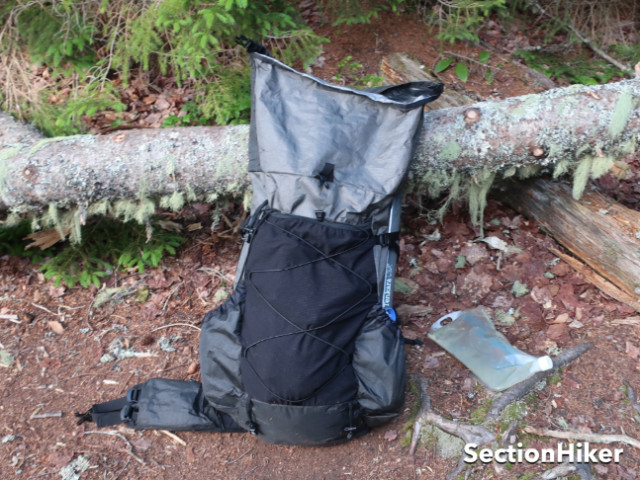
The side water bottle pockets are easy to reach while wearing the backpack and you can get bottles in and out of the pockets. There is also elastic with a cord lock along the top of the pocket to secure taller bottles. The pack’s shoulder straps are anchored inside these pockets to pull the pack closer to your hips, but small items can fall out if placed inside them. The pockets are sized for tall bottles but you can just barely secure a 32 oz Nalgene in one with the elastic cord (I prefer milky white UL polyethylene Nalgenes over Smartwater bottles, which get scuzzy with use and are hard to keep clean.)

The rear mesh pocket is great for storing wet or loose layers you want easy access to, without having to open up the roll top. The Ultra 24 Circuit I review here has a more durable grade of Dyneema Mesh which is a $20 upgrade that is well worth the added durability if you plan to hike off-trail. The pack comes with an elastic cord that lays over the mesh and is good for attaching wet gear to the outside of the backpack, although my preference is to remove it so it doesn’t snag on protruding vegetation.
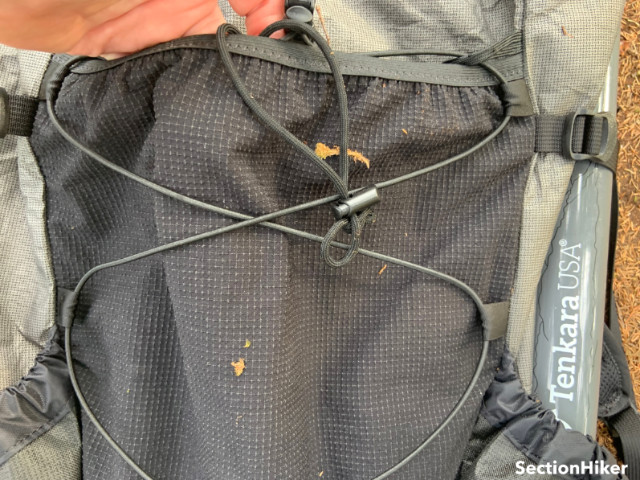
There are two zippered pockets on the exterior of the hip belt, large enough to store a point-and-shoot camera, snacks, Aquamira bottles, bug dope, and such. The fronts of both pockets are hard-faced with heavy-duty zippers for durability. Hip belt pockets are a place that often experiences high abrasion if you hike off-trail and where the Ultra fabric shines. They also come with water-resistant zippers which is a nice touch if you have to hike in rain.
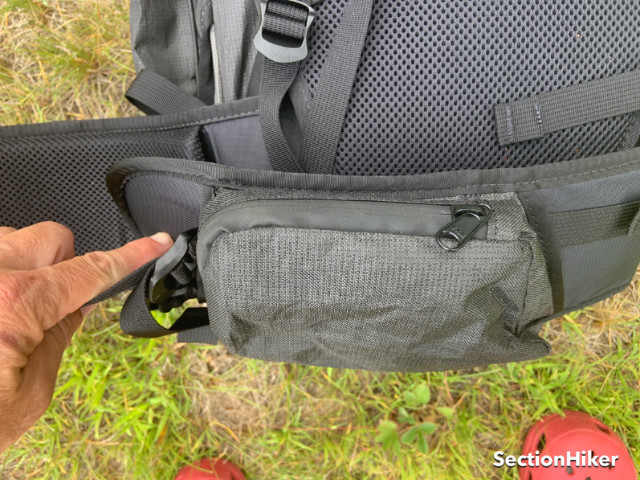
The inside of the pack bag is one big space without any hydration ports or a place to hang a hydration system, although there are two gear loops inside from which to hang a hydration pocket or smaller accessory pocket (sold separately). While the entire pack can hold 68L, the main pack bag only has a volume of 39.3L of storage while the extension collar adds another 8.2 Liters of closed storage. The remainder is spread around the exterior of the pack.
The inside of the pack bag is also NOT seam-taped, despite the fact that the other manufacturers including Zpacks and LiteAF are seam-taping Ultra or offer it as a pack option like Superior Wilderness Designs. That feels like a pulled punch to me, even more so given that most DCF packs are now seam-taped as well.

Regardless, we still always recommend using a pack liner, even on packs that are seam taped and made with waterproof fabric, because a liner has more uses beyond keeping the inside of your pack dry. (See: Do You need a Pack Liner for a Waterproof Backpack?)
Backpack Frame and Suspension
The Ultra 24 Circuit has two frame components, a Delrin (fiberglass) hoop that runs around the perimeter of the back panel and a central aluminum frame stay. The hoop doesn’t provide a structural function in terms of load transfer although it provides an anchor for the pack’s load lifters. The real work is done by the frame stay, which also prevents any barrelling, even when the pack is stuffed full. The frame stay is pre-curved and helps drive the load into your lumbar region without a noticeable lumbar pad. Both the Delrin loop and the central frame stay components are not designed to be easily removable.
In terms of load distribution, it’s best to place your heaviest items, such as food, closer to the center of your back or just above the hip belt. Weight placed higher up in this pack, with its single frame stay, tends to sway a bit and can throw you off balance.
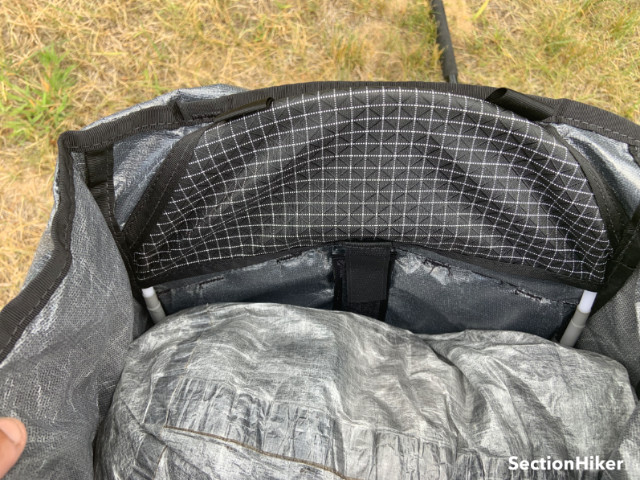
The back of the pack is made with thin foam which is covered with mesh fabric that does an excellent job of keeping your torso comfortable even on hot and humid days. It’s not ventilated like a suspended mesh pack, so you’ll still sweat, but it’s also not smooth like a back panel made with nylon, and therefore much less slippery when you’re slippery with perspiration.
Like ULA’s other backpacks, the Ultra 24 Circuit is available with traditional male (J-shaped) or female-friendly and unisex (S-shaped) shoulder straps…although a lot of men prefer those S-shaped straps as well. I requested them on this pack to show you what they look like. The S-Shape is good for people with sloping shoulders or well-developed chests and can help make the sternum strap (which slides up and down on a webbing strap) more comfortable. ULA packs are very popular with women backpackers for this reason.
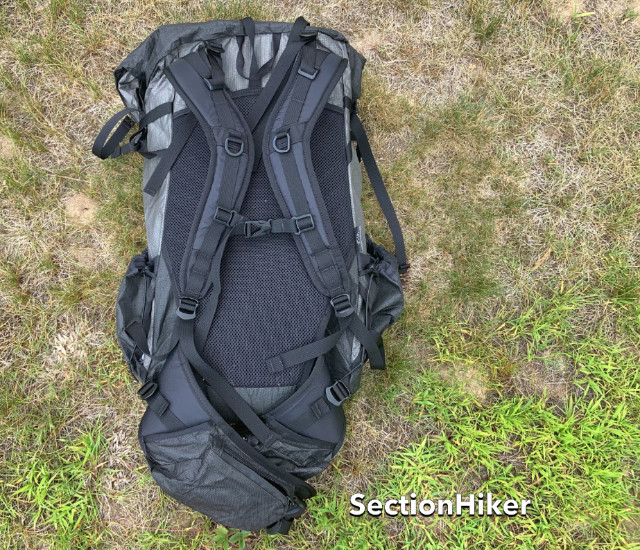
The hip belt is equally impressive, if not more. It has top and bottom webbing straps so you can adjust the tension to match the curves of your hips while preserving the simplicity of a central buckle. I think the ULA Circuit backpack has the best hip bet available today amongst ultralight pack makers in this weight class in terms of fit, comfort, and load transfer. It rides securely and comfortably over your iliac crest and won’t slip even if you have a heavily loaded pack.
The hip belt is also replaceable and available in an impressive range of sizes, so you can really dial in a good fit even if you’re on the ultra-slim or the oversized end of the spectrum. It attaches to the pack with a big block of velcro behind the padded back panel. That velcro block is taller than it has to be by about 2″, so if you need to, you can raise the hip belt up and shorten the torso length or vice versa. In other words, you get the convenience of an adjustable torso length without incurring the added weight and complexity that having one usually requires. This degree of adjustability has always been a feature of ULA larger backpacks that have set them apart from other fixed torso-length packs.
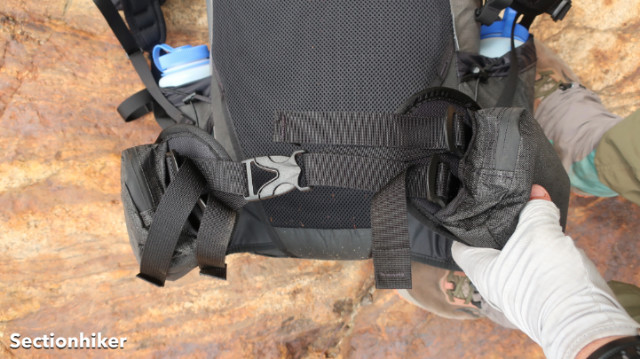
External Attachment Points/Compression
There’s one tier of compression straps on the Ultra 24 Circuit located above each side pocket. In addition to helping compress puffy gear stored inside the pack, they can also be used to secure long skinny items to the side of the pack like a Tenkara fishing rod tube or a trekking umbrella. They do have limited utility for winter hiking and backpacking, however, when it is much more convenient to use a pack with two tiers of side compression straps for hauling snowshoes or skis.
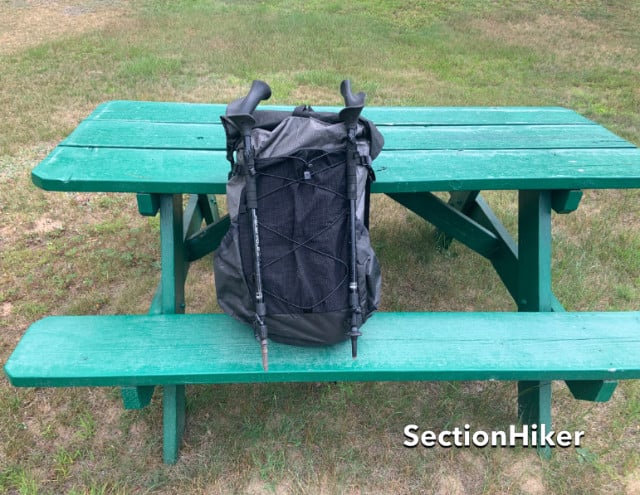
Like all ULA backpacks, the Ultra 24’s Circuit’shoulder straps provide plastic rings to hang gear like GPS receivers or a Garmin mini 2. The sternum strap slides up and down a piece of webbing sewn to the front of the shoulder straps and is easy to adjust (since it’s not sewn like a daisy chain).
There are also seven gear loops sewn into the pack’s seams that circle its perimeter which hold a crisscrossed adjustable elastic cord good for lashing items to the pack, although you can easily rig up extra cords any way you please or remove the elastic strap, which is my preference. The Ultra 24 Circuit also includes a pair of trekking pole holders that run down the outside of the pockets, but they can be difficult to use if you keep winter baskets on your poles year-round.
Recommendation
The ULA Ultra 24 Circuit is a 68L backpack designed for multi-day backpacking in harsh conditions. It’s made with a pack material called Ultra that is significantly more abrasion resistant than Dyneema DCF or the 400D Robic Nylon used in the regular Circuit backpack also sold by ULA. Other than the material switch, both the Ultra 24 Circuit and the regular 400D Robic Nylon Circuit are basically the same.
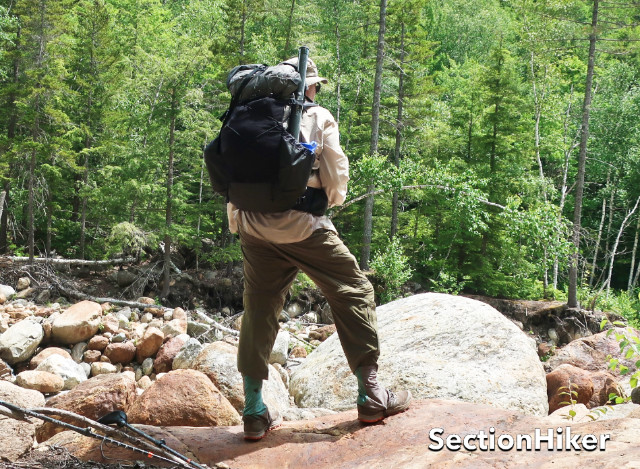
If you’re considering purchasing a ULA Circuit the things that set it apart from other manufacturers’ backpacks are sizing and fit. If you require special sizing in terms of height or girth, or you want S-shaped shoulder straps, the Circuit or any of ULA’s other higher volume packs are really hard to beat.
If you backpack in mountainous terrain, desert, or canyon control which are highly abrasive terrain, investing in the more durable Ultra 24 Circuit makes a lot of sense if your total pack weight is 30 lbs or less. The Ultra 24 Circuit is only a few ounces lighter than the regular ULA Circuit, so switching based on weight alone isn’t going to make a huge difference. In addition, the Ultra 24 isn’t seam-taped, so you really don’t gain much in terms of water resistance even though the pack is made with waterproof fabric.
But you also shouldn’t short-change the baseline 400D Robic Nylon Circuit. It’s an incredibly tough fabric and a great value, which is why so many thru-hikers and long-distance backpackers swear by it. The Robic Circuit is also available in a huge range of colors and color combinations if you want to let your freak flag fly. Either way, you really can’t go wrong whichever ULA Circuit you pick.
Disclosure: ULA loaned us a backpack for this review.
SectionHiker is reader-supported. We independently research, test, and rate the best products. We only make money if you purchase a product through our affiliate links. Help us continue to test and write unsponsored and independent gear reviews, beginner FAQs, and free hiking guides.

